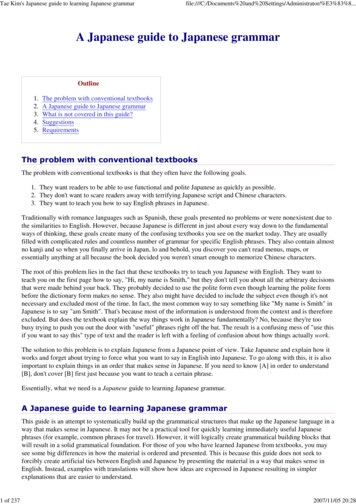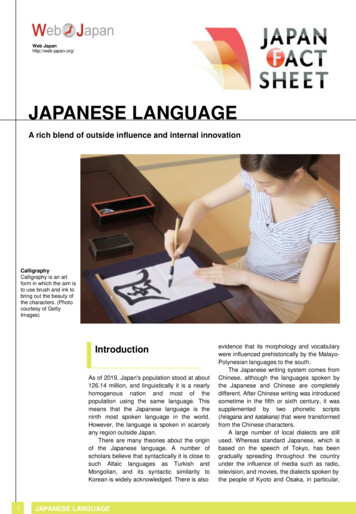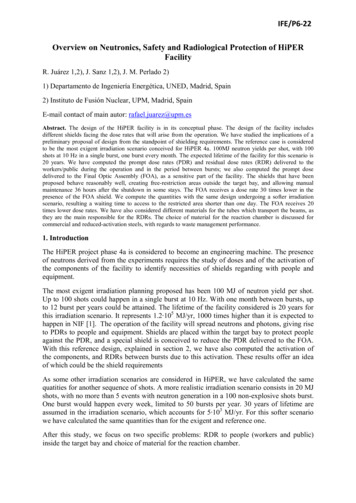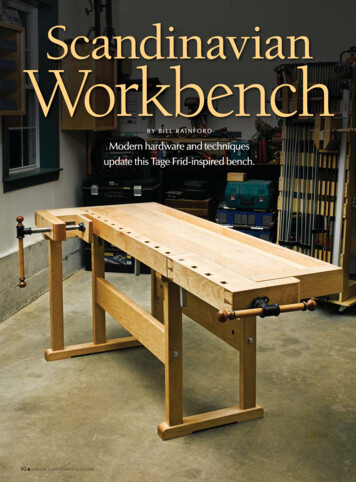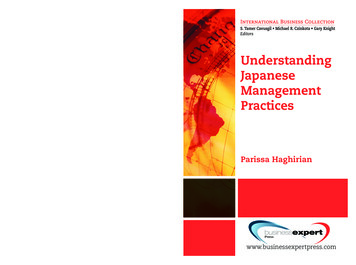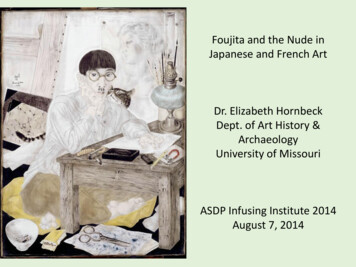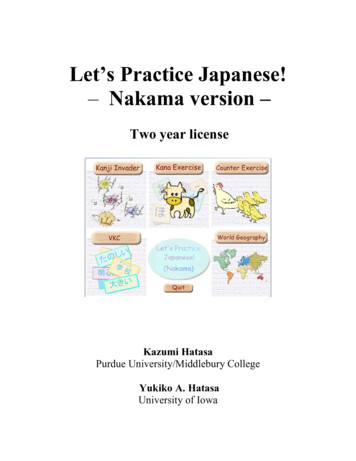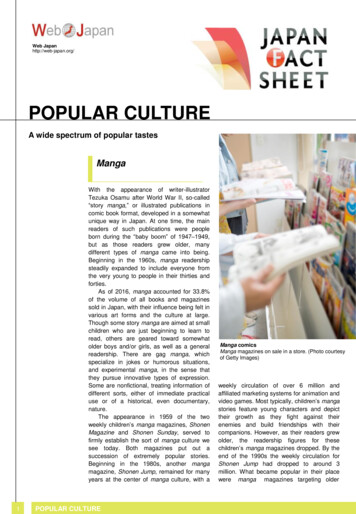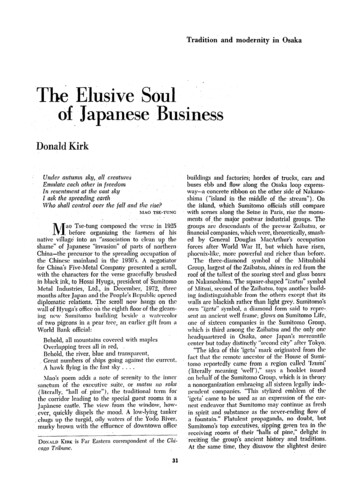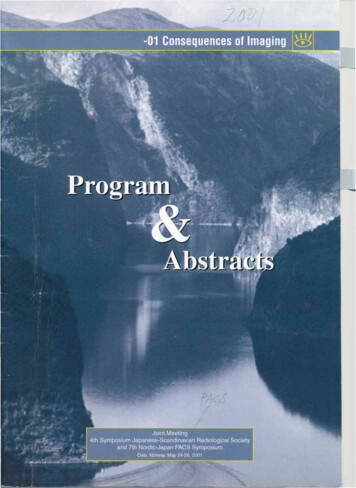
Transcription
JAPANESE-SCANDINAVIAN RADIOLOGICAL SOCIETYPresident, Japanese Side: Tatsuo Kumazaki, TokyoPresident, Scandinavian Side: Frode Lrerum, OsloHonorary Meeting Presidents:Ivar Enge, Lillehammer (N)Takahiro Kozuka, Osaka (J)Local Organising CommitteeMeeting President: Frode LrerumSecretary: Per Kristian HoIAndreas AbildgaardMorten StirisOlaug RooJunro Hosaka (special liaison to Japan for local committee)Scientific CommitteeTatsuo Kumazaki (J)Masayoshi Akisada (J)Hans Ringertz (S)Masao Sako (J)Niilo Saranummi (Fin) . Kiyonari Inamura (J) /:!SHolger Pettersson (S)Tetsuo Okabe (J)Martti Kormano (Fin)Chikasumi Kuroda (J)Alf Kolbenstvedt (N)Takaaki Hosoya (J)Finn Mathiesen (Dk)Junro Hosaka (J)Erik Fosse (N)Silas Olsson (S)Asbjorn Nordby (N)Uno Eriksson (S)Thorgeir P3.1sson (ISL)Jarl A. Jakobsen (N)Frode Lrerum (N)Sponsors:Japan-Scandinavia Sasakawa FoundationNycomed Amersham Inc.Fuji Medical Systems
,jvi.)-J.).") H(-p)C !J W,[He- ( rrv.J.fvSCIENTIFIC PROGRAM& /IL,) I "l. ,(y-Friday 25 May 2001oCJ/y.n-1pc CoW?/ c:{u/)-vyv-l -L ;;t.-w09:00 - 09:30Opening Session.09:30 - 10:30Session 1. Plenary lectures.Chairs: T. Kozuka (1),1. Enge (N)09:30Honorary lecture.Experiences with the first Interventional Centre in Japan.T. Kumazaki, Tokyo, Japan10:00Invited lecture.Data models in radiology information systems: Matching the real world to the DICOMstandard.A. A gaard, Oslo, Norway10:30 - 10:45Coffee Break10:45 - 12:45Session 2. Plenary. Free papers.Chairs: T. Okabe (1), J. A. Jakobsen (N)10:451.HOW TO MAKE A PACS PROJECT A SUCCESSFUL STORYJaakko Kinnunen, Hanna Pohjonen.Hospital Djstrict of Helsinki and Uusimaa; Helsinki University Hospital; Radiology; MeilahtiHospital; POB 610; FIN-00029 HUS, Finland[) 10:572.DEVELOPMENT OF DEPARTMENTAL RISIPACS COMBINED WITH AHOSPITAL-WIDE PACS: DlCOM AND WEB-BASED SYSTEMK. Miyasaka, S. Terae, T. Nambu, K. Kudoh , Y. Watanabe, T. Tsuzuki.Department of Radiology, Hokkaido University Graduated School of Medicine and UniveristyHospital, Sapporo, JapanD11:093.TELERADIOLOGY· LOGISTICS, SECURITY AND AUTHENTICATION ISSUESO. RAdI, A. Abildgaard2 Departments of lIT and 2Radiology, Rikshospitalet, University of Oslo, Norway11:214.EVALUATION OF THE RADIOLOGISTS DIGITAL WORKING ENVIRONMENTHans Rin2ertz.Department of Radiology, Karolinska hospital, Stockholm, Sweden11:335.IMPLEMENTATION OF NETWORK TECHNOLOGIES IN HEALTH CAREMargunn Aanestad.The Interventional Centre, Rikshospitalet and Department of Informatics,University of Oslo, Norway.()11:45 -11:55a11:55Break6.·deyuki Takeshita!, Yasuhiko Okural, Michihiro Sasagaki 2,HideakiYoshim ra'2, Yhi Matsumura3 , Hiroshi Takeda3 lSchoold Health Sciences, Faculty of Medicine Osaka University, 2Department ofRadiology, Osaka University Medical School and 3Department of Medical Information Science,Osaka University Hospital, Osaka, Japan '--"- r n am,-, ura lA·
Q12:077.5QUANTITATIVE CLINICAL EVALUATION OF COMPRESSED MOTION IMAGE BYOR DIGITAL CINE ANGIOGRAPHY.Okura1, . Matsumura2 , K. Hidaka l , K. Inamura3, H. Yokoyama4, H. Inadas.Id t chool of Medicine Cour e of Health Sciences, Osaka University, 2Department ofICormation Sciences, Osaka University Hospital, 3School of Allied Health Sciences,Fa&.ul y of medicine, Osaka University, 4Department of Radiology, National Cardiovascular Center,Osaka, Japan, sGraduate School of Technology, The University of Tokyo, Hongo, Japano12:198.TIME-ORIENTED DATA WAREHOUSE BASED ON THE MEDICALNT M ODELYuichir amamot , I, Hirokazu Narnikawa2, Kiyonari Inamura3.10 saka ,sit , Graduate Scbool of Medicine, Course of Health Science,2NEC Software Kansaiand 30 saka D. . ersity, Faculty of Medicine, Osaka, Japan-012:319.COMPARISON OF HARD AND SOFT·COPY CONFERENCE IN INTENSIVE CAREMarianne Maass, Marjatta Kosonen and Martti Kormano.Department of Diagnostic Radiology, University of Turku and Turku University Central Hospital,Turku, Finland12:45 - 13:45Lunch13:45 -15:30Session 3. Plenary. Free papers.Chairs: H. Tajima (J), K. Solheim (N)13:4510.ACUTE MASSIVE PULMONARY THROMBOEMBOLISM: A COMBINEDAPPROACH WITH MECHANICAL FRAGMENTATION USING A ROTATING PIGTAILCATHETER, LOCAL FmRINOLYSIS, AND CLOT ASPIRATION.Hiroyuki Tajimal , Tatsuo Kumazaki l , Satom Murata l, Kazuo Ichikawa l, Pascal Niggemann l, KenNakazawa l, Madoka Nakahara i, Junro Hosaka l, Morimasa Takayama2, Keiji Tanaka2, TeruoTakano2 Departments of iRadiology and 2Intemal Medicine, Nippon Medical School, Tokyo, Japan13:5711.MAGNETIC RESONANCE GUIDED BIOPSY OF MUSCULOSKELETALLESIONS ON A 0.23 T OPEN MR IMAGERR.K. Parkkola1, K.T. Mattilal, J.T. HeikkiUe, T.O. Ekfors 3, M.A. Kallajoki 3, M.E.S. Komu i, T.J.Vaara4, H.T. Aro2.Departments of iRadiology, 2Surgery and 3Pathology of Turku University Hospital,Kiinamyllynkatu 4-8, FIN-20S20 Turku, and 4Marconi Medical Systems Finland, Inc., Ayritie 4,FIN-015 10 Vantaa, Finland14:0912.REALISM IN SIMULATORS FOR ROBOTIC SURGERYJan Sigurd Rotnes.The Interventional Centre, Rikshospitalet, Oslo, Norway14:2113.A HYBRID TECHNIQUE FOR PERCUTANEOUS RADIOFREQUENCY THERMALABLATION OF OSTEOID OSTEOMAS: CONCEPT, TECHNIQUE, AND RESULTSM. Hauserl , I LIoret., S Skjeldal2.Departments of IRadiology and 2Surgery, Norwegian Radium Hospital, Oslo, Norway14:3314.THE POSTERIOR PARAVERTEBRAL APPROACH FOR CT FLUOROSCOPYGUIDED MEDIASTINAL BIOPSIES: A SAFE ACCESS ALSO TO THE MIDDLEMEDIASTINUMM. Hauser1 , pA Wolff\ HM 0Iemd2.3.Departments of lRadiology and 2Medical Physics and Technique, The Norwegian RadiumHospital, Oslo, Norway; and 3Norwegian Radiation Protection Authority, 0stenis, Norway14:45 -15:00Coffee Break
oo10:10 -10:25CoffeBreak10:25 -11:40Session 7. Parallel. Free papers. "Store Auditorium"Chairs: K. Miyasaki (J), M. Kormano (F)100 "1A(.\; '--" PAC (y Cl -\.QUALITY CONTROL OF IMAGE MONITORS INAaro Kiuru.Turku University Central Hospital (TUCH), 20520 Turku, Finl dI.10:3722.PERFORMANCE OF GENERAL PURPOSE COLOR MONITORS OF PACS IN THEWARDSH. Kondoh, H. Nishitani.Department of Medical Information Science, Tokushima University Medical Hospital, Tokushima,Japan.10:4923.VENOGRAPHY: COMPUTED RADIOGRAPHY (CR) V.S. FILM-SCREEN SYSTEMJunro Hosaka, Tatsuo Kumazaki, Hiroyuki Tajima, Satoru Murata, Madoka Nakahara, KenNakazawa.Department of Radiology and High-tech Research Center, Nippon Medical School, 1-1-5 Sendagi,Bunkyo-ku, Tokyo, 113-8603, Japan11:0124.CHANGING RADIOLOGICAL WORK PRACTICESMargunn Aanestad.The Interventional Centre, Rikshospitalet and Dept. of Informatics, University of Oslo, Norway.o11:1325.CHARACTERISTICS OF RADIOLOGICAL IMAGE VIEWING PROGRAMSMarkku Iivanainen.University of Turku, Diagnostic Radiology, Turku, FinlandD11:2526.ARcmTECTURE OF HUSpacs and HUSnetHanna Pohjonen, Risto Laakkonen and Jaakko KinnunenHospital District of Helsinki and Uusimaa; Helsinki University Hospital; Radiology;Meilahti Hospital; POB 610; FIN-00029 HUS, Finland10:25 - 11 :40Session 8. Parallel. Free papers. "G,.,;nt Auditorium"Chairs: K. Inamura (J), M. Stiris (N)10:25 YELOPMENT OF COMPUTER PROGRAM FOR THE LONG-TERMP OGNO TIC ANALYSIS OF LARYNX CANCER TREATED WITH RADIOTHERAPYJ\NDSUR ERYy. Ohno1,Sugiyama l , S. Kasaharal, A. Oshima2, H. Tsukuma2, W. Ajiki2.ISchof Allied Health Sciences, Osaka University, 20 aka Medical Center for Cancer and Cardiovas ular' Diseases, Osaka, Japan27.r10:3728.DIAGNOSING LUNG VENTILATION and PERFUSION DISORDERSAaro Kiuru, Erkki Svedstrom.Turku University Central Hospital, 20520 Turku, Finland10:29.ON-TABLE ANGIOGRAPHIC FINDINGS IN OFF-PUMP CORONARY BYPASSSURGERY, AND ITS USEFULNESS AS PREDICTOR FOR LATE PATENCY OUTCOME.Per Kristian Holl, Erik Fosse l , Runar Lundblad 2, Sigurd Nitter-Hauge3, Karleif Vatne4, Hans-J rgenSmith4. 'The Interventional Centre, 2Department of Thoracic Surgery, 3Department of Cardiology,4Department of Radiology, Rikshospitalet, University of Oslo, Oslo, Norway11:0130.DEVELOPMENT OF THE SYSTEM WmCHAUTOMATICALLY ACQUIREOPTIMA DISCRETE-VALUED ATTRIBUTE BY DIVIDING AND GROUPINGUS-VALUED ATTRIBUTE TO ASSIST THE CLINICAL DECISION-MAKINGRADIOTHERAPY.H .Kou1 , H Harauchi 2, K. Inamura2 Qrac!uat choo) of Medicine, Course of Health Science and 2School of Allied Health Sciences,Facu of Medicine, Osaka Universityc.eNTn
o1.HOW TO MAKE A PACS PROJECT A SUCCESSFUL STORYJaakko Kinnunen, Hanna Pohjonen.Hospital District of Helsinki and Uusimaa; Helsinki University Hospital; Radiology; Meilahti Hospital; POB 610;FIN-00029 HUS, FinlandObjective: The PACS of the Hospital district of Helsinki and Uusimaa, HUSpacs, belongs to the most largest PACSinstallations in the world: altogether 800000 examinations yearly stored digitally to the centralized database. TheHUSpacs will be completed at the end of year 2003.Material and methods: 1) Start in building a wide social contact network among the clinicians and the hospital'sadministration staff. 2) Make sure, that your basic infrastructure is OK: a high-speed redundant network, a radiological information system (RIS) steering the filmless imaging process, a digital scheduling system, digital imagingmodalities supporting at least the most essential Dicom service classes. 3) In order to get support for your ideasmake first a realistic business plan with expenditures and earnings and total revenues. Link the plan also to the organisation's mission, vision, values, goals and strategies. 4) After getting support for your ideas, proceed with a detailed implementation plan including a timeframe with milestones and short technical and clinical summaries. 5)Produce a short marketing movie of PACS and its benefits. 6) Get the support of the highest level of the organisation; make them feel themselves as driving forces in the project: invite them for members of the steering group ofthe project. 7) Choose one or two of your best radiographers for PACS maintenance tasks. 8) Organize a PACSproject group comprising also key clinicians and IT-specialists of your own as well as those of the PACS-vendor. 9)Organize a PACS project group for every hospital: choose key clinicians for members as well. 10) Have at least oneacademic IT-specialist as a consultant and at least one IT-engineer from your own staff. 11) Benchmark all relevantPACS-sites. 12) When choosing the vendor, make sure, that you are going to get enough technical support. 13) Inorder to get the clinicians acceptance for the final big bang, promise them a 5-10% discount later. 14) Before the bigbang test the system with single filmless days. 15) Make the radiologists and clinicians face the fact, that light boxesand auto-alternators disappear at one weekend.Results and discussion: There are now two filmless hospitals in the district. The project schedule has been madeeven quicker and the board members accepted a remarkable amount of loan for the project. Rationalization benefitsare clearly seen by radiologists and clinicians as well as politicians deciding on the financial resources.2.DEVELOPMENT OF DEPARTMENTAL RISIPACS COMBINED WITH A HOSPITAL-WIDE PACS:DICOM AND WEB-BASED SYSTEMK. Miyasaka, S. Terae, T. Nambu, K. Kudoh, Y. Watanabe, T. Tsuzuki.Department of Radiology, Hokkaido University Graduated School of Medicine and Univeristy Hospital, Sapporo,JapanObjectives: To maintain rapid transmission of images and smooth workflow, high-speed network and user-friendlyterminals are mandatory. Recently, we implemented a PACS integrated with a Web-based RlS that spanned the entireworks in the department. The system was combined with the hospital- wide HISIPACS. We present the system regarding image data processing and management in radiology department.Materials and Methods: All the digital imaging modalities (about 50), image workstations and RlS terminals wereconnected to Gigabit Ethernet switch. The image data were stored in multi-vendors servers with DICOM and withlossless compression. At the image workstations, the data were fetched from the DICOM servers by query/retrieval.RlS was constructed by Web-based resources and it comprised those of radiological ordering, examination booking,nursing support, accounting, reporting, drugs and materials, and so on.Results: For 1.5 years duration, 150,000 examinations and 4,300,000 images (3.8TB) have been accumulated in thedepartmental DICOM servers. The data volume was almost the same as had been estimated before installation of thesystem; but CT data were 1.5 times larger than ones at estimation. CT and MR images were retrieved from theDICOM servers within 0.5 second/image. The images were interpreted exclusively on the workstations with 2-4CRT monitors. Workflow including reservation of examination, ordering radiological examinations, reporting, exposure-data collection, transmission of nursing data was smooth by using Web-base RlS.Conclusions: Softcopy diagnosis is accepted. Web-based RlS is suitable for management of works in radiologydepartment.
-3.TELERADIOLOGY - LOGISTICS, SECURITY AND AUTHENTICATION ISSUESO. Rad l, A. Abildgaard2.Departments of lIT and 2Radiology, Rikshospitalet, University of Oslo, Norway RY11J O bj ective: Solutions for Teleradiology has been implemented in several of the Counties/Regions in Norway. Whyare they accepted and actively in use at some sites and not in others? Having implemented PACS, at two sites, whatare the requirements for implementing and utilising teleradiology between them - regarding logistics, standards,security and authentication?Material and Methods: Interviews and discussions with users and usergroups at hospitals in Norway, both Technical and Medical staff. Literature/Standards: Dicom 3.0 and llIE Technical Framework.Results and Conclusion:Teleradiolgy solutions that are implemented in a separate network - not connected to local infrastructure at the sending and receiving hospital- are rarely used - though they are operative technically. Regionsykehuset i Troms (RiT )are actively using their Teleradiology network for "remote reading". The success seems to be that the remote hospitals that are sending images to RiT are sharing RIS with RiT -
HOSPITAL-WIDE PACS: DlCOM AND WEB-BASED SYSTEM K. Miyasaka, S. Terae, T. Nambu, K. Kudoh, Y. Watanabe, T. Tsuzuki. Department of Radiology, Hokkaido University Graduated School of Medicine and Univeristy Hospital, Sapporo, Japan TELERADIOLOGY· LOGISTICS, SECURITY AND AUTHENTICATION ISSUES O. RAdI, A. Abildgaard2 Departments of lIT and 2Radiology,
